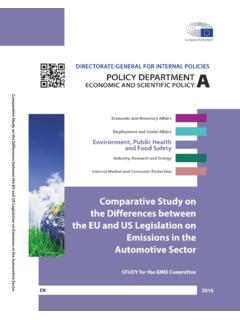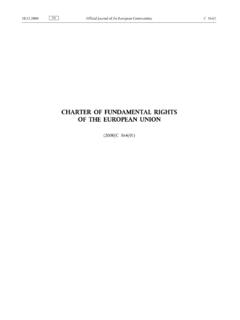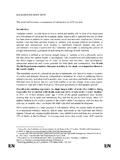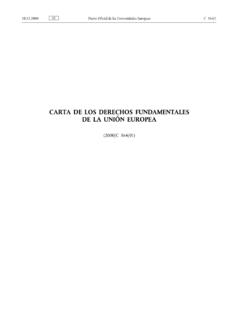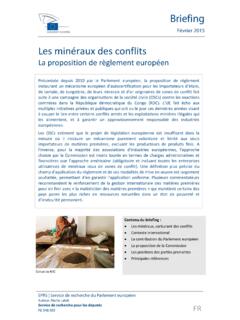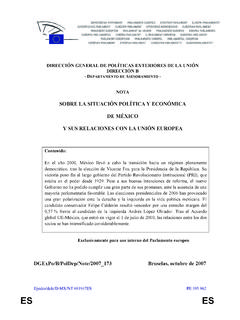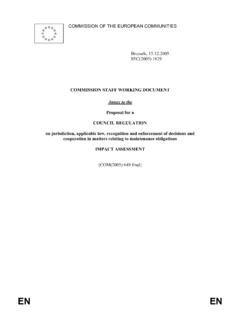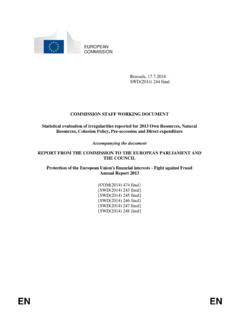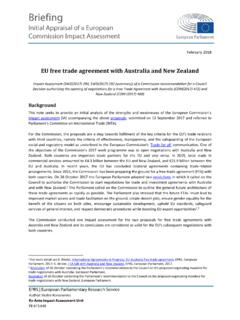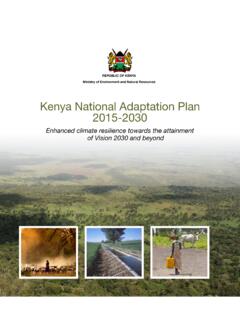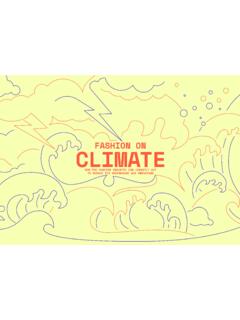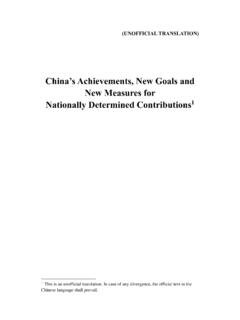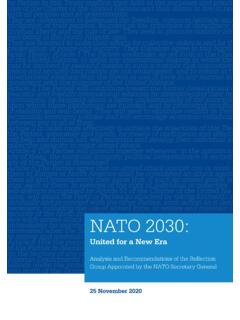Transcription of The concept of 'climate refugee' - European Parliament
1 BRIEFING EPRS | European Parliamentary Research Service Author: Joanna Apap Members Research Service PE February 2019 EN The concept of ' climate refugee' Towards a possible definition SUMMARY According to statistics published by the Internal Displacement Monitoring Centre, every year since 2008, an average of million persons around the world have been forcibly displaced by floods, windstorms, earthquakes or droughts. This is equivalent to one person being displaced every second. Depending on the frequency and scale of the major natural disasters occurring, there are significant fluctuations in the total number of displaced people from one year to the next, yet the trend over recent decades has been on the rise. Many find refuge within their own country, but some are forced to go abroad. With climate change, the number of ' climate refugees' will rise in the future. So far, the national and international response to this challenge has been limited, and protection for the people affected remains inadequate.
2 What adds further to the gap in the protection of such people who are often described as ' climate refugees' is that there is neither a clear definition for this category of people, nor are they covered by the 1951 Refugee Convention. The latter extends only to people who have a well-founded fear of being persecuted because of their race, religion, nationality, membership of a particular social group or political opinion, and are unable or unwilling to seek protection from their home countries. While the EU has so far not recognised climate refugees formally, it has expressed growing concern and has taken action to support and develop resilience in the countries potentially affected by climate -related stress. This briefing is an update of an earlier one of May 2018. In this Briefing Issue The complex task of defining ' climate refugee' Gaps in the international legal framework How climate change contributes to the refugee problem Towards a European framework Outlook EPRS | European Parliamentary Research Service 2 Issue The number of international migrants worldwide has continued to grow rapidly in recent years, reaching 258 million in 2017, up from 220 million in 2010 and 173 million in 2000.
3 Since the international conference on population and development in 1994, the issue of international migration and its relation to development has risen steadily on the agenda of the international community. The United Nations (UN) 2030 Agenda for Sustainable Development includes several migration-related targets and calls for regular reviews of progress towards their achievement using data disaggregated by, inter alia, migratory status. The annual displacement of millions of persons worldwide due to environmental disasters needs to be addressed. Many find shelter within their own country, but some are forced to go abroad. In the context of climate change, such movements are likely to increase. So far, the response to this challenge has been limited, and protection for those affected remains To address the issue of such large movements of refugees and migrants, on 19 September 2016 the UN General Assembly adopted the New York Declaration for Refugees and Migrants, in which it called for the development of two global compacts, one on refugees and one on 'other migrants', endorsed on 17 December 2018 in New York and on 10 December 2018 in Marrakech respectively.
4 While the reasons for the internal or international displacement of individual migrants or diasporas vary, the UN Internal Displacement Monitoring Centre (IDMC) and the Norwegian Refugee Council identify natural disasters as the number one cause for this phenomenon. With rising sea levels, desertification and extreme weather events, climate action must be a part of any meaningful agreement on refugees or migrants. ' climate refugees', migrants who move due to natural disasters and climate change, are now recognised in the 2018 global compact on safe, orderly and regular migration under its Objective 2. This compact aims to protect the rights of those displaced and help address the root economic, environmental and social drivers that are compelling people to leave their communities and countries. However, the current text lacks actionable commitments to control the numerous man-made forces underlying global mass migration.
5 There is a clear protection gap with regard to ' climate refugees', who are neither clearly defined as a category nor covered by the 1951 Convention relating to the Status of Refugees (the 1951 Refugee Convention). The latter extends only to people who have a well-founded fear of being persecuted on grounds related to race, religion, nationality or membership of a particular social group or political opinion, and are unable or unwilling, owing to fear of persecution, to seek protection from their home countries. This definition is not applicable to people displaced for reasons related to the environment, as it would be difficult to consider environmental degradation as 'persecution' in the sense in which it is used in the Refugee Convention. It would also be necessary to link such persecution to one of the grounds set out in the convention. Therefore, environmentally induced displacement falls outside the scope of the 1951 Refugee Convention and its additional protocol.
6 This means, for instance, that the estimated 200 000 Bangladeshis, who become homeless each year due to river-bank erosion, cannot easily appeal for resettlement in another country. It also means that the residents of the small islands of Kiribati, Nauru and Tuvalu, where one in ten persons has migrated within the past decade, cannot be classified as refugees, even though those who remain are 'trapped' in worsening environmental conditions. Of the 186 countries assessed in a recent survey on climate vulnerability, Chad was rated as facing the greatest peril. The fact that this country has one of the fastest-growing populations in the world only compounds the problem. In the future, environmental changes could have enormous effects on many populations, especially those in coastal and low-lying areas such as Vietnam, the Netherlands and certain parts of the US. 'Already, people are now twice as likely to be displaced than they were in the 1970s', according to Justin Ginnetti from the IDMC.
7 This is due to the combined effect of rapid population growth, urbanisation and exposure to natural disasters. The concept of ' climate refugee' 3 The complex task of defining ' climate refugee' The phenomenon of ' climate refugees' has been in the public discourse since 1985, when UN Environment Programme (UNEP) expert Essam El-Hinnawi defined 'environmental refugees' as: '.. those people who have been forced to leave their traditional habitat, temporarily or permanently, because of marked environmental disruption (natural and/or triggered by people) that jeopardied their existence and/or seriously affected the quality of their life'. This definition is also used for the term ' climate refugees'; whether there is a practical difference between 'environmental' and ' climate ' remains unclear. One of the key challenges in securing protection for those affected by displacement as a result of climate change lies in the complexities involved in defining the term ' climate refugee', while also taking the pre-existing discourse surrounding the Refugee Convention and previous attempts to define 'environmental refugees' into account.
8 Despite the likelihood of a growing number of climate refugees, there is no international legal recognition for such a group, even if the term 'environmental refugees' has been in use since the 1970s; the International Organization for Migration (IOM) estimates that there could be as many as 200 million such refugees by 2050. The meaning of the term ' climate refugee' is most uncertain in the context of law and practice. The core issue here has to do with the effectiveness of rights and the legal certainty. Where there is no legal provision for an individual right because the subject matter is not covered by law, then the individual cannot be guaranteed international protection as a matter of law. The notion of human displacement occurring as a result of climate change is a relatively recent conceptualisation compared to the more traditional ideas associated with refugees, such as persecution based on race, religion, nationality, membership in a particular social group or political opinion.
9 The UN Refugee Agency (UNHCR) hopes that the Nansen initiative, launched in 2012 by the governments of Norway and Switzerland, will set an agenda for future action. Part of the difficulty of planned resettlement is that there is no best practice to guide the process. According to the UNHCR, previous examples of 'development-forced displacement and resettlement (DFDR)', where large-scale infrastructure projects aimed at strengthening the economies of displaced people, have usually resulted in the relocated population being worse off than they were before. All too often the resettlement programmes have been so poorly planned, financed, implemented and administered, that they have left local people permanently displaced, disempowered and destitute. Ensuring that climate -induced planned resettlement is dealt with humanely and effectively will require careful policy planning so as to avoid the mistakes of the past.
10 The term 'environmental refugee' has been advocated as a means of defining ' climate refugee;' however, it is too broad to encompass the realities of ' climate refugees'. According to academic researchers Docherty et al. (2009),2 a ' climate refugee' definition should include the following parts: 'forced migration, temporary or permanent Some commonly used definitions: The term 'environmental refugee' has been used in position papers presented by various NGOs, but also in the media and the academic literature. The term is especially associated with the early stages of reflection on the topic, before a distinction started being drawn between the different types of environmental change and forms of mobility. It was used to raise awareness and to focus on the forced nature of displacement. However, the use of the term and the status of 'refugee' assigned to people in this situation have subsequently been criticised, primarily because the term has a specific legal meaning in the context of the 1951 Refugee Convention and international refugee law.
